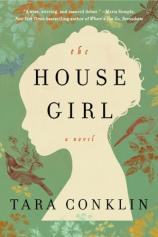Author Talk: February 14, 2013
Tara Conklin’s highly-anticipated debut novel, THE HOUSE GIRL, intertwines the story of an escaped house slave in 1852 Virginia with that of an ambitious young lawyer in contemporary New York, who is given the difficult assignment of finding the perfect plaintiff to lead an historic class-action lawsuit involving reparations for descendants of American slaves. In this interview, Conklin reveals how reading a biography of Virginia Woolf helped provide the inspiration for this book and describes the challenges she faced writing from two very different character perspectives.
Question: What inspired you to write THE HOUSE GIRL?
Tara Conklin: I was reading a biography of Virginia Woolf and came across the term “slave doctor” used to describe one of her long-lost relations. Those words caught my imagination. I thought about the circumstances that would drive a person to occupy such a conflicted role --- to be a healer, but one whose patients were destined only for more hardship and pain. As I thought about this slave doctor, an image popped into my head of a man on a horse, holding his hand out to a young woman, a slave, and pulling her up onto the horse. That was the beginning of THE HOUSE GIRL --- those words and the image they evoked.
Q: In the novel, you use two very interesting angles to help tell the story --- a reparations lawsuit and the unveiling of a controversial art exhibit. Why did you decide to use these events?
TC: I had already written the historical narratives of Caleb Harper, Dorothea Rounds and Josephine Bell before either the art exhibit or reparations lawsuit entered into the story. After finishing their sections, I put the entire project aside due to family and work commitments. But I couldn’t stop thinking about the characters --- I didn’t feel that their stories were complete. A contemporary counterpart seemed the only way to bring some closure to what they had experienced and endured. The reparations idea was fairly straightforward for me --- throughout my legal education and career, I’ve always been interested in how the law has been used to address large-scale atrocities, with international tribunals, truth commissions and the like. I had never studied reparations within the American context, however, so it was exciting to research and learn about this new angle. The art component evolved organically in the story. From the very beginning, I knew that Josephine was an artist but I questioned how, as a slave, she would have the resources, time and space to create art. These practical concerns influenced the development of her relationship with her mistress Missus Lu and from there came the idea of the authorship controversy. It also seemed a fitting metaphor for some larger themes in the book --- of forgotten history and the importance of truth-telling.
Q: You were born in St. Croix, the US Virgin Islands and grew up in Stockbridge, Massachusetts. How has growing up in these two vastly different environments influenced you personally, and as a writer?
TC: My parents left St. Croix when I was still a baby, so I don’t remember much. The stories that they told about St. Croix --- their experiences working in a local school, the island’s history of slavery --- were vivid and compelling and stayed with me over the years. Still, I don’t think I realized their place in my imagination until I started writing Josephine’s story. Stockbridge is a very small, old New England town full of history and art (Norman Rockwell lived and painted there). Freed slaves were buried in our town graveyard and I remember learning about the Underground Railroad in elementary school. Those stories had such an immediacy for me as a child but, again, I don’t think I realized how much they had stayed with me until I started writing.
Q: What was the research process like for this book? Did you come across any information that surprised you?
TC: As I was writing, I read a number of slave narratives, histories of American slavery and novels set during the time period. At a certain point, though, I had to stop reading --- the stories and statistics were so overwhelming that I felt nearly paralyzed by them. Who was I to try to write about American slavery? So I focused instead on this one person, on Josephine Bell, and I tried to tell her story as honestly as I could. What surprised me most in my research was the lack of information and resources available about the experiences of individual slaves. I was surprised that today no national museum of slavery exists and no national monument dedicated to those who lived and died as slaves.
Q: THE HOUSE GIRLfollows the lives of two young women separated by more than a century and who lead very different lives, one as a slave the other a lawyer in New York City. Did you find it difficult to write from these two very different perspectives? Were there any similarities between the two women?
TC: I found each challenging for different reasons. On paper, Lina is certainly similar to me --- she’s a lawyer, from the northeast, white. I felt comfortable writing the details of her life --- how her law firm operated, what she ate for lunch --- but it was much more difficult for me to figure out what she wanted. Why was she so intent on uncovering Josephine’s story? Josephine was difficult for different reasons --- the extrinsic details were totally foreign to me, but I felt that I knew her character on a more basic level. I think there are a lot of similarities between the two women: Lina and Josephine are both strong-willed, tenacious, intelligent women. They both want to know the truth about their own personal histories but are also afraid of what they might find. And they are both searching for a sense of home and a sense of freedom.




